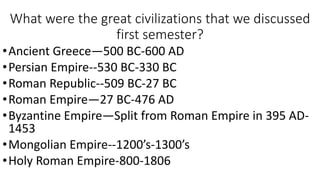The document provides an overview of several major civilizations and empires from ancient history, including Ancient Greece, the Persian Empire, the Roman Republic and Empire, the Byzantine Empire, and the Mongolian Empire. It then discusses the Middle Ages in Europe, known also as the Medieval period or Dark Ages, and explains why this era is sometimes referred to as the Dark Ages due to raids and a lack of focus on learning. Finally, it covers several topics related to Christianity during this time period such as reforms in the Catholic Church, the development of architecture like Romanesque and Gothic cathedrals, and the Crusades launched by the Pope to recapture the Holy Land from Muslim rule.








































































































































